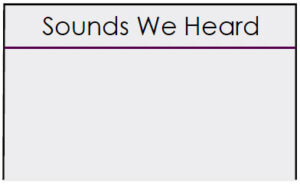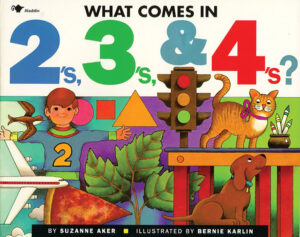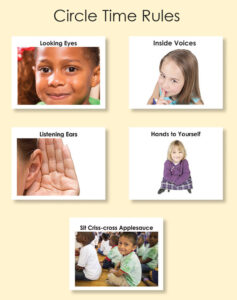Phonological awareness
Children will listen to and identify single sounds.


Review:

Be Prepared: Write the following at the top of a chart paper: Sounds We Heard. Today’s listening game follows a three-part sequence: (1) introduce four different sounds with children’s eyes open; (2) invite children to close their eyes and you make one of the sounds previously demonstrated; (3) ask children to open their eyes and call on one child to guess the sound you made. The three-part sequence is repeated until each child has an opportunity to identify a sound. When appropriate, hide items you use for making a sound in a box with a lid. Write sound names on chart paper. Make single sounds that may be familiar to children. Possibilities include:
| blowing a whistle | water running | coughing |
|---|---|---|
| crumpling paper | clicking with tongue | knocking on a door |
| closing a door | stomping | cutting with scissors |
| hammering | sharpening a pencil | stapler |
| clapping | zipper | snapping fingers |
| phone ringing | whistling | opening a drawer |
| ringing a bell | turning pages of a book | blowing nose |
| rubbing hands together |
Today we will play a listening game. We will listen to sounds and try to guess each sound. Show us your listening ears!
[Point to your ears.]
Remember, when we use our listening ears we pay close attention to what we hear.
I have a stapler. Let’s listen carefully to the sound it makes.
[Demonstrate use of a stapler.]
Now let’s listen to the sound of my fingers snapping.
[Demonstrate snapping fingers.]
Let’s listen to the sound of a zipper zipping.
[Demonstrate a zipper zipping.]
Let’s listen to one more sound. Let’s listen to me knocking on the door.
[Demonstrate knocking on the door.]
Now we will listen to the sounds with our eyes closed. We can pay better attention to what we hear when our eyes are closed. After we close our eyes, I will make one of the sounds we just heard. Then we will try to guess the sound.
I will ask one person to tell us the sound after we open our eyes. This way we can make sure everyone gets a turn to tell us a sound. Please do not say the name of the sound out loud unless it is your turn.
I will hide in this box some of the things that may make a sound.
[Point to box.]
Are you ready to use your listening ears? Okay! Let’s close our eyes.
[After all children have closed their eyes, make one of the sounds introduced previously. After you’ve made the sound, hide the sound-making item in the box (if appropriate), ask children to open their eyes, and invite one child to guess the sound. If other children offer ideas, remind them that everyone will have a turn to guess a sound. We need to wait for our turn.]
What was the sound?
I am going to write the names of the sounds we hear on our chart.
[Point to chart and to each word in the chart’s title as you read the words.]
 The words at the top of the chart say Sounds We Heard. I will write the word _____ on our chart.
The words at the top of the chart say Sounds We Heard. I will write the word _____ on our chart.
[After you write the sound word on the chart, point to the word and read it aloud.]
We are working hard to use our listening ears! Let’s close our eyes and listen to another sound.
[Of the three remaining sounds introduced with children’s eyes open, make one sound at a time with children’s eyes closed. After each sound, encourage children to open their eyes. Ask one child to identify the sound. After writing the name of each sound on the chart, point to the word and read it aloud.
After each of the initial group of four sounds has been identified, demonstrate four more sounds with children’s eyes open. Then ask children to close their eyes and use the same procedure for encouraging children, one at a time, to guess a single sound you make. Continue this sequence until each child gets a turn.]
Today we played a listening game. We closed our eyes and listened to a sound. Then we opened our eyes and guessed the sound. Each of us had a turn to guess a sound. Let’s look at our chart to remember all of the sounds we guessed in our listening game. Our chart says Sounds We Heard.
[Point to each word as you say it.]
We heard _____.
[Point to and say the name of each sound on the chart.]
We guessed a lot of sounds!
Extra support
Enrichment
Provide a basket of items that can be used to make sounds. Examples: bell, drum, baby rattle. Encourage children to take turns secretly choosing an item and making a sound with it as the other children close their eyes and guess the sound.
Invite children to try this game outside. Invite school-age children to use outside toys and items to make sounds. Examples: tricycle, ball, swing. Encourage preschool-age children to guess what made each sound.
Number knowledge
Children will verbally count up to five items.


Review:

We are practicing how to count. When we count, we say numbers to know how many. Let’s count five fingers together and say a number for each finger.
[Lead children in counting out loud as they point to each finger.]
Now, let’s all clap five times. Remember, we need to say one number with each clap so we know how many times we’ve clapped. This is counting!
[Encourage children to count with you as you clap five times. Say the number each time you clap.
Display book cover.]
 Today we will read a book called What Comes in 2’s, 3’s, & 4’s?
Today we will read a book called What Comes in 2’s, 3’s, & 4’s?
Do you think our book will be about counting? (yes!)
[Introduce the book by pointing to the title of the book as you read it.
Today we read a book called What Comes in 2’s, 3’s, & 4’s? We counted groups of things on each page. When we count, we say numbers to know how many.
Extra support
Enrichment
Provide *small dot cards with 1, 2, and 3 dots on each of five cards (total of 15 cards). Mix up the cards. Invite children to sort the cards into three piles by number of dots.
*Printables provided
Provide children with several copies of Five Little Monkeys Bake a Birthday Cake. Encourage preschoolage children to find groups of two in the book. Examples: Two eyes on each monkey, two pots on the stove. School-age children will enjoy finding larger groups in the book such as groups of 10. Examples: 10 monkey feet, 10 monkey hands.
Self-control
Children will understand circle time rules.


Review:

Be Prepared: This activity introduces or reviews your classroom’s rules for circle time. Examples of typical rules are included in the activity. Place pictures of children following circle time rules on a chart with rules listed by each picture (see example below). Pictures in the sample chart are provided.
Yesterday we reviewed our classroom rules. Remember, a rule tells us how to behave. Who can tell us one of our classroom rules and then show what it looks like?
Today we will talk about our rules for circle time. When we sit together during circle time, there are rules that help us to learn, get along, and pay attention. Let’s review some of our circle time rules.
Let’s practice our circle time rules. When we practice our rules, we will show each other what they look like.
 [Go through each rule, pointing to the rule on the chart as it is being practiced. Encourage children to show how each rule should look. Examples:]
[Go through each rule, pointing to the rule on the chart as it is being practiced. Encourage children to show how each rule should look. Examples:]
Our circle time rules help us in many ways. When we use our looking eyes and listening ears we can better pay attention to the things we are learning. Circle time rules also help us get along with each other and respect our neighbors.
What circle time rules help us get along with each other and respect our neighbors? (quiet voices, hands to yourself, criss-cross applesauce)
When we are quiet, we can hear what others are saying. When we keep our hands to ourselves and sit criss-cross applesauce, we help the people around us also look and listen.
Today we reviewed our circle time rules. Who can tell us why we have rules for circle time? (they help us learn, they help us get along, they help us pay attention) What is one of our circle time rules?
Extra support
Enrichment
In the housekeeping center, encourage children to use dolls to role play circle time in their classroom.
Discuss other rules that might be specific to your setting. Invite school-age children to write the rules on a chart as all children discuss the rules.
Appreciation of art, music, drama, and dance
Children will understand some ways to be creative in classroom centers.


Review:
Be Prepared: Today’s activity involves a tour of selected centers in your classroom for the purpose of discussing creative things children might do. Select centers that were not included in your Week 1, Day 2 visit to 2–3 centers (Social-Emotional). Focus on centers that provide good opportunities for a range of open-ended activities (sensory area, art, writing, etc.).
We can do creative things in many places in our classroom. Remember, we use our ideas to make or do something new when we are creative.
Today we will visit some of our centers to talk about ways we can be creative. We will go to centers we did not visit last week.
[As a group, walk to a center. At each center, engage children in a discussion of:
[Build on children’s interests and comments during the tour to emphasize creative efforts. Examples: “Amal saw different colors of pencils in the writing center. He wants to be creative in writing his name with different colors.” “Tamika saw play dough in the sensory center. She had an idea to be creative in making a pizza.” “Sam has an idea of painting red and blue trees in our art center.”]
Extra support
Enrichment
Invite preschool-age and school-age children in your setting to bring something from home that they have created for a “share and tell” discussion with all children. Encourage children to describe their ideas and how they were creative when making the item.